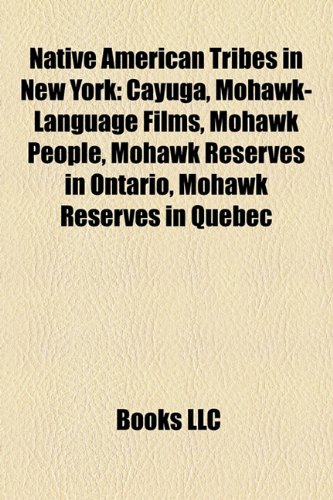The traditional natives of the North American continent used tomahawks as weapons and tools. Your midpoint tomahawk is a sort of hatchet with a very level shaft.
It was originally a Native American tool, but the first European colonists decided to start using tomahawks too. Tomahawks also made good weapons if you knew the right tomahawk fighting techniques, which can even animated throwing the weapon.
Mohawk Indian Tribe
The very first Native American tomahawks were made from stone, such as polished soapstone. The blades and handles were usually intricately carved and designed. Flint rock, deer horns, and the jawbones of big animals were often used to create tomahawks.
Native American tribes in New York: Tuscarora people, Mahican, Mohawk people, Lenape, Iroquois, Seneca people, Ramapough Mountain Indians Best
Rate This Product :

Native American tribes in New York: Tuscarora people, Mahican, Mohawk people, Lenape, Iroquois, Seneca people, Ramapough Mountain Indians Overview
Please note that the content of this book primarily consists of articles available from Wikipedia or other free sources online. Pages: 58. Chapters: Tuscarora people, Mahican, Mohawk people, Lenape, Iroquois, Seneca people, Ramapough Mountain Indians, Akwesasne, Oneida Indian Nation, St. Lawrence Iroquoians, Oneida people, Wappinger, Metoac, Cayuga people, Cayuga Nation of New York, Shinnecock Indian Nation, Onondaga people, Neutral Nation, Ganienkeh, Montaukett, Tonawanda Band of Seneca Indians, Seneca Nation of New York, Siwanoy, Shekomeko, New York, Oswegatchie people, Esopus tribe, List of American Indian Reservations in New York, Wenrohronon, Lamoka people. Excerpt: The Lenape (pronounced or) are a group of several organized bands of Native American people with shared cultural and linguistic characteristics. Their name for themselves (autonym), sometimes spelled Lennape or Lenapi, means "the people." They are also known as the Lenni Lenape (the "true people") or as the Delaware Indians. English settlers named the Delaware River after Lord De La Warr, the governor of the colony at Jamestown, Virginia. They used the exonym above for almost all the Lenape people living along this river and its tributaries. At the time of European contact in the 16th and 17th centuries, the Lenape lived in the area referred to as Lenapehoking, roughly the area around and between the Delaware and lower Hudson Rivers. This encompassed what are now known as the U.S. state of New Jersey; eastern Pennsylvania around the Delaware and Lehigh valleys; the north shore of Delaware; and much of southeastern New York, particularly the lower Hudson Valley, Upper New York Bay, Staten Island and western Long Island. They spoke two related languages in the Algonquian subfamily, collectively known as the Delaware languages: Unami and Munsee. Lenape society was organized into clans determined by matrilineal descent. Territory was collective, but divided by clan. At the time of European contact, ...Customer Reviews
*** Product Information and Prices Stored: Jan 05, 2012 22:50:21
You'll find that most cultures have their own version of a tomahawk or a hatchet tool. In fact, even the way you use them is very similar to the Native American tomahawk fighting techniques.
The British population had their belt axes, and the French wielded the fransica. The Vikings were infamous for their skill in using axes in battles.
Tomahawks were more than just tools or weapons: They could also be used for smoking tobacco. The opposite side of the blade would usually have a pipe bowl built into it.
Considering the turbulent connection the Native American tribes had with early European settlers, the dual purpose of the weapon was very appropriate.
The tomahawk was doubly useful this way. It could be used as a smoke peace offering, or it could be turn into a weapon of war if things turned sour in the middle of the parties-- and they very often did!
The tomahawk can be used by itself, or it could be complemented with another weapon. The second weapon would usually be a long bladed knife. This is an effective and deadly combination that works for a collection of combat situations, and also against whether single or complicated opponents.
A tomahawk can be used as whether a weapon of offense or defense. A lot of tomahawk fighting techniques help the weapon serve both of these roles. A tomahawk can be used to rake, chop, punch, slice, catch and pull, or even deflect blows.
Native American Tomahawk Fighting TechniquesUnseen Tears Trailer Tube. Duration : 2.08 Mins.Produced by Native American Community Services of Erie and Niagara Counties, Inc. Funded by the Community Foundation for Greater Buffalo Native American families in Western New York continue to feel the impact of the Thomas Indian School and the Mohawk Institute. Survivors speak of traumatic separation from their families, abuse, and a systematic assault on their language and culture. Western New York Native American communities are presently attempting to heal the wounds and break the cycle inter-generational trauma resulting from the boarding school experience. Unseen Tears documents testimonies of boarding school survivors, their families, and social service providers. Unseen Tears won best documentary at the SUNYWide Film Festival 2010 and was an official selection of the Lights Cameras Help film festival
Tags: residential school, native, native american, NACS, Squeaky wheel, Thomas indian school, indian school, mohawk institute, mush hole, new york, western new york, canada, human rights, abuse, school, survivors, buffalo, new, york, Brantford, ontario, boarding, United, States, upstate, Niagara, tralier, unseen, tears, city, father, toronto, nyc, dad, daughter, Boarding School, alchemicalmedia




No comments:
Post a Comment